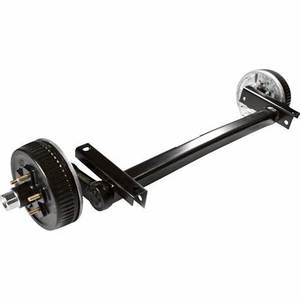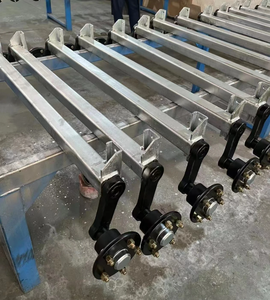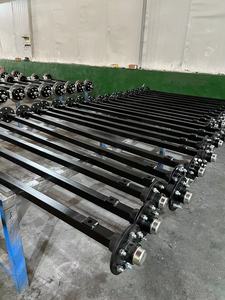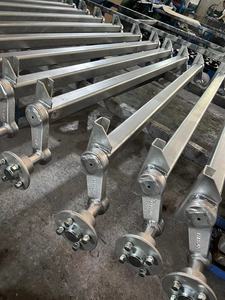
All categories
Featured selections
Trade Assurance
Buyer Central
Help Center
Get the app
Become a supplier

(10514 products available)




















































Cart axles are the bars or shafts that are used to wheel rotation on carts. They are an important part of any cart as they help to keep the wheels in place and allow for smooth movement. There are different types of cart axles, each designed for a specific purpose and application. Here are some common types of cart axles:
Here is the specification and maintenance of the cart axle:
Load Capacity
Each cart axle has a maximum load capacity it can carry without damage. Know this value to avoid exceeding it. This value is expressed in pounds or kilograms.
Material
Cart axles are made of strong durable materials. For example, Steel, Aluminum, and Cast Iron. Each material has its advantages. Steel axles are strong and can handle high loads. While aluminum axles are lighter and resists rust.
Length
The length of the cart axle affects the stability and size of the cart. Longer axles give wider wheel spacing. This causes the cart to be more stable. The length is measured in inches or millimeters.
Diameter
The diameter of the cart axle affects the fit and strength. Axles with larger diameters are stronger and can carry more loads. However, the diameter of the axle must match the size of the wheel hub. The diameter is measured in millimeters or inches.
Tread
The tread is the distance between the outside of one wheel to the outside of the other wheel. This affects the stability of the cart. A larger value causes the cart to be stable. It also affects the space needed to store the cart. The tread is measured in millimeters or inches.
Wheel Size
Cart axles are designed to work with specific wheel sizes. The diameter of the wheel is given in inches or millimeters. For example, 12 inches or 300 millimeters. The axle diameter should match the wheel hub for a perfect fit.
Brake Compatibility
Some cart axles are designed with brakes or space for brake parts. This is important for carts that need more stopping power. For example, heavy-duty carts used in factories. Check that the axle and brake system work together safely.
To keep a cart axle in good working condition, follow these maintenance tips:
Cleanliness
Keep the cart axle clean. Dirt and dust will cause wear and tear on the axle. Use a damp cloth or soft brush to remove any dirt or dust from the axle.
Lubrication
Lubricate the axle parts regularly. This reduces friction and makes the axle last longer. Use the right lubricant for the axle material. For example, use grease or oil.
Inspection
Inspect the axle often. Look for signs of damage like cracks or bends. Check that the length, diameter, and other specifications of the axle are still the same.
Load Management
Do not overload the cart axle. Carry loads below the maximum load capacity. This prevents damage to the axle or other cart parts.
Replacement
Replace the axle if it is damaged beyond repair. Choose a new axle that meets the requirements of load capacity, length, diameter, and other specifications.
With the wide variety of cart axles available for carts today, it can be quite a challenge knowing where to start. Here are some key factors to consider when choosing a cart axle:
Weight Capacity
When choosing a cart axle, it is important to consider the weight capacity. This will be determined by the axle shaft. For heavy loads, a cart with a strong heavy-duty axle shaft should be used. An example of a cart with a heavy-duty axle shaft is a golf cart. A golf cart axle is designed to carry heavy loads, such as people and their golf equipment, and has a high weight capacity. For light loads, a cart with a smaller axle shaft should be used. This is because a smaller axle shaft is easier to push or pull, making it perfect for light loads.
Material
Cart axles come in different materials, each with its own advantages and disadvantages. Steel is a commonly used material for cart axles because it is very strong and durable. However, steel is very heavy, making it difficult to push and pull the cart. Aluminium cart axles are lighter than steel axles, making them easier to push and pull. The downside of aluminium axles is that they are not as strong as steel axles. For example, when pushing or pulling the cart, it may bend or break easily. Plastic cart axles are the lightest. This makes it the easiest to push and pull. However, plastic cart axles are not durable and can easily break or bend with heavy loads.
Terrain
Before choosing a cart axle, consider the terrain. This is important because different cart axles are designed for different terrains. For example, a cart axle with rugged wheels should be used for rough terrain. The rugged wheels and axle will allow the cart to go through the rough terrain without getting damaged. However, the rugged wheels and axle on the cart will not work well on paved roads. This is because the wheels will be uneven and bumpy on the paved roads.
Cart Size
When choosing a cart axle, it is important to consider the cart size. This is because different cart axles are designed for different cart sizes. For example, a cart axle designed for a small cart will not fit properly on a large cart. This can cause problems when using the cart. To avoid this, ensure that the cart axle chosen is the right size for the cart.
Here is a step-by-step guide on how to DIY and replace cart axles:
Identify the Problem
Inspect the cart carefully to understand what is wrong with the axle. Check for signs of wear or damage, such as cracks, bent metal, or difficulty wheel movement.
Gather Necessary Tools and Materials
Get the tools needed for the cart axle replacement. This may include a wrench, screwdriver, hammer, or pliers. Also, get the new axle that will be replaced.
Prepare the Cart
To replace the axle, the cart should be in a stable position. The cart should be turned upside down or on its side. This will make it easier to work on the axle.
Remove the Wheels
The next step is to remove the wheels from the cart. Depending on the type of cart, the wheels may be attached with nuts, bolts, or clips. Use the appropriate tool to remove the fasteners and take the wheels off.
Remove the Old Axle
Once the wheels are removed, the old axle can now be seen. Take note of how the old axle is installed, as this will help with the new installation. Loosen any clamps or brackets holding the axle in place and carefully slide the axle out of the cart.
Install the New Axle
Put the new cart axle in the original position. Make sure it fits properly and is aligned with the cart's body. Tighten any clamps or brackets to hold the new axle in place.
Reattach the Wheels
Now it is time to reattach the wheels to the cart. Depending on the type of cart, the wheels may be attached with nuts, bolts, or clips. Use the appropriate tool to attach the fasteners and take the wheels off.
Test the Cart
Upo completing the above steps, the cart axle replacement has been done successfully. Before using the cart, ensure everything is working well. Flip the cart back and test it to ensure the wheels spin freely and the axle is secure.
Q1: What are the signs of a damaged or defective cart axle?
A1: When an axle is damaged, the cart does not move smoothly. It makes noise like grinding or squeaking. The wheels may wobble or be uneven. The axle may be bent or broken, which is visible when inspected.
Q2: Can carts run on single-axle carts?
A2: Yes, carts can run on single-axle carts. However, it limits the cart's design and functionality. A single-axle cart is used for basic applications like handcarts or wheelbarrows.
Q3: What is the maintenance tips for cart axles?
A3: Regularly lubricating the axle bearings is important. Inspect the axle and wheels for wear or damage. Ensure all bolts and nuts are tightly fastened. Do not overload the cart; this prevents axle problems. Keep the cart clean, removing dirt from the axle parts.